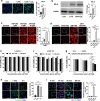Targeted theranostic photoactivation on atherosclerosis
- PMID: 34689768
- PMCID: PMC8543964
- DOI: 10.1186/s12951-021-01084-z
Targeted theranostic photoactivation on atherosclerosis
Abstract
Background: Photoactivation targeting macrophages has emerged as a therapeutic strategy for atherosclerosis, but limited targetable ability of photosensitizers to the lesions hinders its applications. Moreover, the molecular mechanistic insight to its phototherapeutic effects on atheroma is still lacking. Herein, we developed a macrophage targetable near-infrared fluorescence (NIRF) emitting phototheranostic agent by conjugating dextran sulfate (DS) to chlorin e6 (Ce6) and estimated its phototherapeutic feasibility in murine atheroma. Also, the phototherapeutic mechanisms of DS-Ce6 on atherosclerosis were investigated.
Results: The phototheranostic agent DS-Ce6 efficiently internalized into the activated macrophages and foam cells via scavenger receptor-A (SR-A) mediated endocytosis. Customized serial optical imaging-guided photoactivation of DS-Ce6 by light illumination reduced both atheroma burden and inflammation in murine models. Immuno-fluorescence and -histochemical analyses revealed that the photoactivation of DS-Ce6 produced a prominent increase in macrophage-associated apoptotic bodies 1 week after laser irradiation and induced autophagy with Mer tyrosine-protein kinase expression as early as day 1, indicative of an enhanced efferocytosis in atheroma.
Conclusion: Imaging-guided DS-Ce6 photoactivation was able to in vivo detect inflammatory activity in atheroma as well as to simultaneously reduce both plaque burden and inflammation by harmonic contribution of apoptosis, autophagy, and lesional efferocytosis. These results suggest that macrophage targetable phototheranostic nanoagents will be a promising theranostic strategy for high-risk atheroma.
Keywords: Atherosclerosis; Autophagy; Efferocytosis; Foam cells; Macrophage targetable phototheranostic agent; Photodynamic therapy.
© 2021. The Author(s).
Conflict of interest statement
The authors have no competing interests to declare.
Figures







References
-
- Benjamin EJ, Muntner P, Alonso A, Bittencourt MS, Callaway CW, Carson AP, Chamberlain AM, Chang AR, Cheng S, Das SR, et al. Heart disease and stroke statistics-2019 update: a report from the American Heart Association. Circulation. 2019;139:e56–e528. - PubMed
-
- Ridker PM. Residual inflammatory risk: addressing the obverse side of the atherosclerosis prevention coin. Eur Heart J. 2016;37:1720–1722. - PubMed
-
- Bourantas CV, Jaffer FA, Gijsen FJ, van Soest G, Madden SP, Courtney BK, Fard AM, Tenekecioglu E, Zeng Y, van der Steen AFW, et al. Hybrid intravascular imaging: recent advances, technical considerations, and current applications in the study of plaque pathophysiology. Eur Heart J. 2017;38:400–412. - PMC - PubMed
MeSH terms
Substances
Grants and funding
LinkOut - more resources
Full Text Sources
Medical
Research Materials
Miscellaneous

